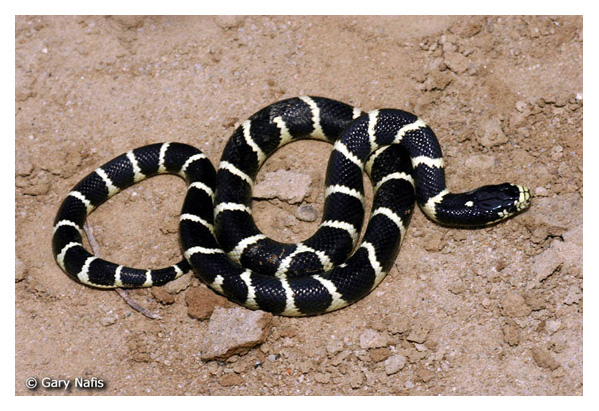Common Kingsnake

Photo - Gary Nafis - CaliforniaHerps.com
Lampropeltis getula
Family: Colubridae Order: Squamata Class: Reptilia
DISTRIBUTION, ABUNDANCE, AND SEASONALITY
Scarce to abundant, the common kingsnake is found throughout California including Santa
Catalina Island off the southern coast. It is absent only from the high mountains of the Sierra
Nevada and from the extreme northwestern and northeastern portions of the state. Widely
distributed, and occurring in nearly all habitats (exclusive of high mountains), the common
kingsnake is most abundant in valley-foothill riparian situations and in other habitats occurring
in the vicinity of irrigated agriculture. Elevation sea level to 2100 m (7000 ft).
SPECIFIC HABITAT REQUIREMENTS
Feeding: Kingsnakes feed on the ground, in mammal burrows, and under surface objects.
Primary foods appear to be lizards and snakes (rattlesnakes exhibit a distinctive defensive
postural response when in the presence of kingsnakes; see Carpenter and Gillingham 1975).
Large numbers of small rodents, birds, and bird eggs are also taken. Kingsnakes have also
been reported to swallow their own shed skins (Keown 1973).
Cover: When inactive, kingsnakes seek cover in rodent burrows and under surface
objects such as flat rocks, logs, and boards. At montane localities with cold winters,
individuals hibernate in rodent burrows and in deep fissures in rock accumulations.
Reproduction: The eggs of the common kingsnake are thought to be laid in loose
well-aerated soil. Cavities in stable talus, abandoned rodent burrows, and rotten logs may
also be used as nest sites.
Water: No information on water requirements. In California this kingsnake is most
abundant near streams and rivers, and in the vicinity of irrigated agriculture.
Pattern: Often found in the vicinity of rock outcrops and clumps of vegetation.
SPECIES LIFE HISTORY
Activity Patterns: Common kingsnakes may be active whenever temperatures are
favorable. During the cooler periods of spring and fall most activity occurs mid-day, but when
summer days are hot most activity is restricted to early morning, and late afternoon and early
evening. Winter inactivity occurs at all localities.
Seasonal Movements/Migration: Predictable seasonal movements have not been reported
for this species in California. It is possible that individuals from montane localities make
annual migrations to and from known hibernacula. Elsewhere individuals apparently spend
periods of winter inactivity in or near the area of their warm-season activity.
Home Range: The nature of the home range of this species in California is unknown.
Territory: No evidence for the territorial defense of resources has been reported for this
species in California. It is probable that males occasionally "fight" during the breeding
season. Male combat has been observed within the genus (Shaw 1951, Moehn 1967).
Reproduction: Clutch sizes range from 2 to 12 (usually 9). Egg-laying usually occurs in
June or July after the mating season, which extends from March to June. Courtship in
kingsnakes is somewhat elaborate and in males involves neck-biting behavior (Leweke
1979). Eggs hatch in about 70 days.
Niche: Because of their activity patterns and local abundance, common kingsnakes are
taken by a wide variety of predators (in spite of the release of a noxious musk from the
postanal glands of disturbed individuals). Predators include mammals, predatory birds,
especially hawks, and other snakes. The nature of competitive interactions between common
kingsnakes and other species with which they coexist is unknown.
source - CDFW
Also see:
Wildlife of Yosemite National Park
Wildlife species typically found in these habitats include black bear, bobcat, gray fox, mountain kingsnake, Gilbert's skink, white-headed woodpecker, ...
Joshua Tree National Park Wildlife
California Kingsnake Lampropeltis getula californiae Found in all communities; most common in canyons with water (common) Red Coachwhip ...
Side-blotched Lizard - Desert Wildlife
Snake predators include rattlesnakes and sidewinders, coachwhips racers, gopher snakes, kingsnakes, patch-nosed snakes, long-nosed snakes and night snakes. ...
Ash Meadows
Some snakes and larger lizards begin emerging from hibernation including gopher snake, common kingsnake, desert spiny, western whiptail, and zebra-tailed ...
Carnivores - Desert Wildlife
Mountain Kingsnake · Roadrunner ...
Common name: California Kingsnake
Size: 19.7-43.8 in (50-111 cm)
Distinguishing characters: A polymorphic species with various color and pattern phases consisting primarily of alternating bands of black or brown, and white or yellow (banded phase) or longitudinal stripes of these same colors (striped phase); some individuals exhibit partial patterns of both and can appear marbled, spotted, or blotched; scales smooth and glossy; snout light colored; single anal scale.
Juveniles: Similar to adults.
Dimorphism: None
Additional notes: Individuals may excrete musk, vibrate tail, and bite when handled. Widespread in many habitats.